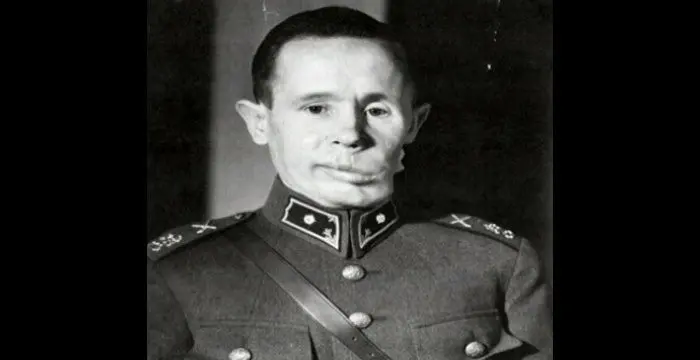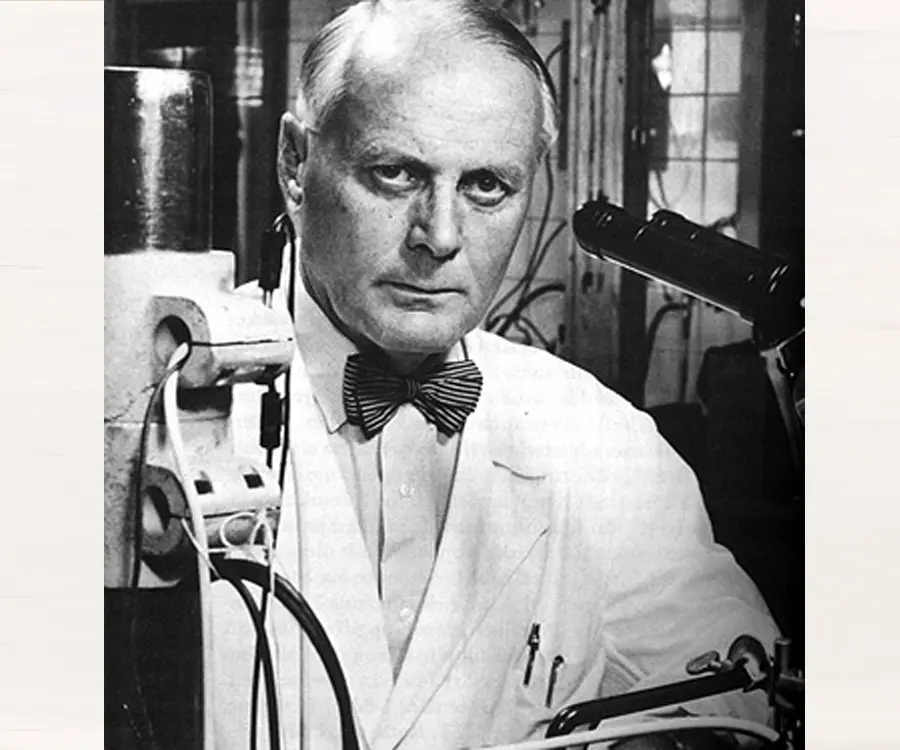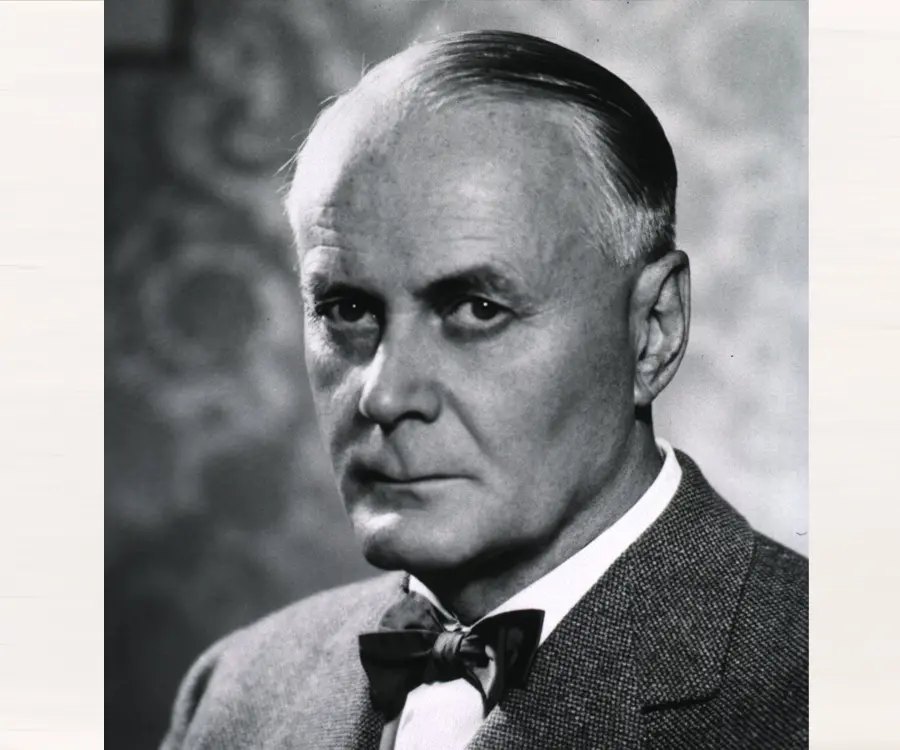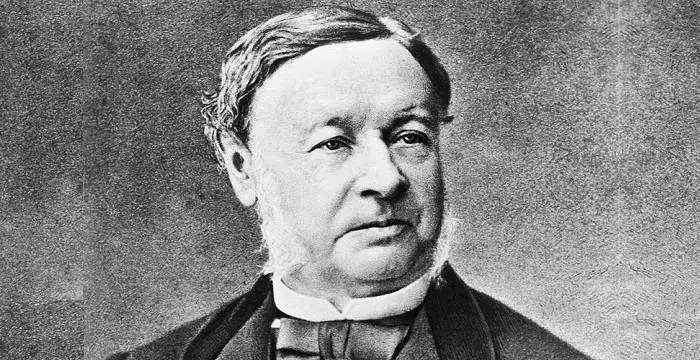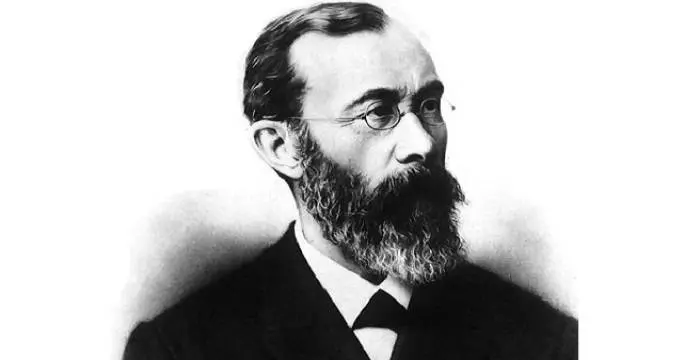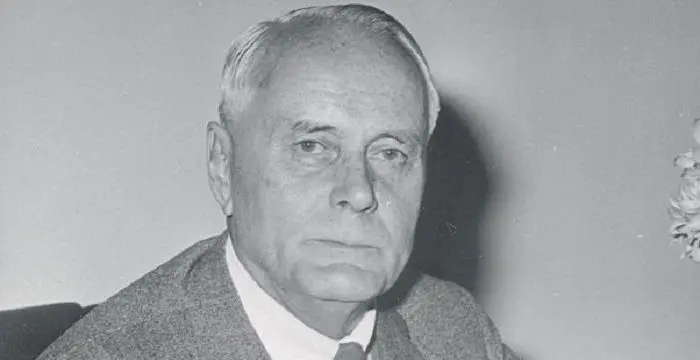
Ragnar Granit - Finnish Men, Family and Personal Life
Ragnar Granit's Personal Details
Ragnar Granit was a Finnish-Swedish Nobel Laureate who made scientific discoveries in the physiology of the retina
| Information | Detail |
|---|---|
| Birthday | October 30, 1900 |
| Died on | March 12, 1991 |
| Nationality | Finns, Swedish |
| Famous | Scientists, Physiologists, Finnish Men |
| Known as | Ragnar Arthur Granit ForMemRS |
| Birth Place | Riihimäki, Finland, Russian Empire |
| Born Country | Finland |
| Gender | Male |
| Father | Arthur Wilhelm Granit |
| Mother | Albertina Helena Malmberg |
| Sun Sign | Scorpio |
| Born in | Riihimäki, Finland, Russian Empire |
| Famous as | Physiologist |
| Died at Age | 90 |
// Famous Finnish Men
Isac Elliot
Isac Elliot is a Finnish pop singer-songwriter and dancer. Let’s have a look at his family & personal life including age, date of birth, girlfriends, net worth, and fun facts.
Robin
Robin Packalen is a Finnish teen pop artist. Check out this biography to know about his childhood, family, personal life, career, etc.
Simo Häyhä
Simo "Simuna" Häyhä was a Finnish sniper, considered the most deadly sniper in war history. Find more about his family, childhood, personal life, career, achievements, etc.
Ragnar Granit's photo
Who is Ragnar Granit?
Ragnar Granit was a Finnish-Swedish scientist who was felicitated with the highly-esteemed Nobel Prize in Physiology or Medicine in 1967 for his discovery concerning the primary physiological and chemical visual processes in the eye. He was a co-recipient of the award and shared it with HaldanKeffer Hartline and George Wald. Interestingly, a highly learned and accomplished scientist and physiologist, medicine wasn’t Granit’s first preference. As a young boy, Granit instead wanted to pursue a career in psychology. However, a chat with his uncle led him to study medicine which eventually became his preferred profession. Granit attained his bachelor degree and later doctorate degree in medicinefollowing which he started his career at the Oxford. It was at his alma mater (University of Helsinki) that Granit made some of the most significant scientific revelations and discoveries that transformed the science behind the visual world. In his career spanning two decades, Granit held important academic positions. He was the honorary member of various professional societies and academies. He retired from Karolinska Institute as Professor Emeritus in July, 1967. A patriotic Finn but a devoted Swedish as well, he quoted that his Nobel Prize belongs ‘fifty-fifty’ to both Sweden and Finland.
// Famous Physiologists
Theodor Schwann
Theodor Schwann was a German physiologist who discovered the Schwann cells in the peripheral nervous system. This biography of Theodor Schwann provides detailed information about his childhood, life, achievements, works & timeline.
Wilhelm Wundt
Wilhelm Wundt was a renowned doctor who conducted pioneering studies on experimental psychology. To know more about his childhood, career, profile and timeline read on
Charles Best
Charles Best was a great scientist and a renowned physiologist who is remembered for being the co-discoverer of insulin. Read this biography to learn about his profile, childhood, life and timeline.
Childhood & Early Life
Ragnar Arthur Granit was born on October 30, 1900 in the parish of Helsinge, Finland to Arthur Wilhelm Granit and Albertina Helena Malmberg. He was the eldest son of the couple and had two younger sisters, Greta and Ingrid Granit. His father was a forestry officer.
When he was very young, the Granit family moved to the neighboring Helsingfors, where his father opened a firm that dealt with sylviculture and forest produce.
Young Granit was first educated at the high school, Swedish Normallyceum. Completing his preliminary education, he enrolled at the Helsingfors University from where he matriculated in 1919. Meanwhile in 1918, while still at school, Granit took part in Finland’s War of Liberation. He was decorated with the Cross of Freedom IV.
Post matriculation, Granit considered a career in law studies and for the same, even took up a summer course at Abo Akademi University in philosophy and Finnish legal language. The course had a deep orientation for psychology, a subject that interested and captivated Granit.
Propelled by the love for psychology, Granit resolved to make a career in the same. However, a stroll with uncle, Lars Ringborn changed Granit’s mind. The latter advised Granit that reading psychology alone would be of no use if he didn’t have knowledge about biology. The conversation deeply impacted Granit who zeroed on studying medicine.
In 1924, he graduated with a Bachelor of Medicine degree from the University of Helsinki. He even obtained a Bachelor of Philosophy degree in theoretical and practical philosophy, aesthetics and chemistry. Three years later, he obtained a doctorate in medicine. He wrote his thesis on the theory of color recognition.
Career
Following his doctorate, Granit traveled to Oxford in 1928 to train under Sir Charles Sherrington. He wanted to understand vision and in the course realized the fact that the retina itself functions as a nerve centre which processes visual information and transmits already processed information to the brain's visual centre.
From 1929 to 1931, Granit was a Fellow in Medical Physics at the Johnson Foundation of the University of Pennsylvania. Therein, he continued bioelectric research as a researcher in medical physics, using the electric measuring technique developed by Edgar Adrian.
In 1932, he returned to Oxford as a Fellow of the Rockfelller Foundation. In 1935, Granit returned to his alma mater, University of Helsinki, where he held the office of Professor of Physiology. Two years later, in 1937, he was formally appointed to the post.
At the University of Helsinki, Granit continued with his electroretinogram bioelectric research on visual nerve and theretina. He worked on Sherrington’s idea that the effect of nerve signals on next nerve cell via synapse can be activating or inhibiting. He became interested in demonstrating the fact that the retina contained inhibiting synapses. For the same, he performed an experiment on a single nerve cell.
He pursued further research on the physiological basis of colour perception. His studies showed that some nerve fibres of the eye were not particularly selective in the case of colour. In fact, they reacted in the same way over the whole spectrum. However, there were other fibres that clearly distinguished between colours. In 1937 Granit published these research results, confirming the theory of colour perception.
Together with Gunnar Svaetichin, Granit observed that the electric impulses generated in the retina, or the electroretinogram, which showed that sensitivity to colour is concentrated mainly in three different groups in the area of blue, green and red. He thus provided the first biological demonstration supporting Young-Hemholz’s three-colour theory.
In 1940, Granit received two offers, one from Harvard University and the other from Karolinska Institutet of Stockholm. He accepted the latter and joined the medical school of the institute. In 1941, he received Swedish citizenship.
In 1945, the Karolinska Institute transformed his laboratory as department of the Medical Nobel Institute. The same year, he became the Director of the Nobel Institute for Neurophysiology in Stockholm.
In 1946, Granit received a personal research chair in Neurophysiology from the Ministry of Education. He retired from the Institute as Professor Emeritus in July, 1967.
In 1947, he published a book, ‘Sensory Mechanisms of the Retina’, which was one of the classics in the field of the electrophysiology of the eye.
In 1965 Granit initiated the series of international Nobel Symposia as contributor to, and as Chairman and Editor of Nobel Symposium I, Muscular Afferents and Motor Control.
Major Works
Granit’s most significant contribution came in as a researcher at Oxford and Helsinki. He is famous till date for his research into the internal electrical impulses that takes place as the eye processes vision. He came up with the theory of colour vision in which he proposed that other than the three kinds of photosensitive cones (the colour receptors in the retina, which respond to different portions of the light spectrum) there are some optic nerve fibres that are sensitive to the whole spectrum, while others respond to a narrow band of light wavelengths and are thus colour-specific. Granit also proved that light could constrain as well as rouse impulses along the optic nerve.
Awards & Achievements
Granit received numerous distinctions and awards from several universities and research institutes in Finland and around the world. In 1961, he received Hans Cronstedt's Prize, Jubilee Medal of the Swedish Society of Physicians, Anders Retzius Gold Medal, F. C. Donders Medal, Sherrington Memorial Gold Medal, Purkinje Gold Medal,Anders Jahren Prize for medicine in the Nordic Countries, the Accademia di Medicina (Turin) St. Vincent Prize
In 1967, he was awarded the Nobel Prize in Physiology or Medicine for his discoveries concerning the primary physiological and chemical visual processes in the eye. He shared the prize with Haldan Keffer Hartline and George Wald.
He gained membership in numerous academies of science, including Finnish Society of Sciences and Letters, Royal Swedish Academy of Sciences (of which he also served as a President in 1963-65), Royal Society of London, National Academy of Science, Indian Academy of Science, American Academy of Arts and Sciences, AccademiaNazionaledeiLincei Rome and Honorary Member of the Accademia di Medicina Turin.
He was an honorary member of several professional societies including the Swedish Societies for Neurology, for Ophthalmology and for Clinical Neurophysiology, the International Society for Clinical Electroretinography, the Biological Societies of Montevideo, Santiago de Chile and Argentina, the Finnish Society for Ophthalmology, the American Physiological Society, the American Neurological Association, the Physiological Society of England, the Finnish Society of Physicians, the Swedish Society of Physicians, the Swedish and the Finnish Societies of Physiology.
Granit was awarded numerous honorary doctorates from universities across the globe including Oslo, Oxford, Lima, Bogotá and Santiago, Hongkong, Chicago, Pisa, Helsinki and Göttingen. The Academy of Finland awarded him the title of Academician in 1985.
Granit served as Visiting Professor of various educational establishments such as Rockefeller Institute, St. Catherine's College, University of the Pacific,
Personal Life & Legacy
Granit tied the nuptials with Baroness Marguerite (Daisy) Emma Bruun, daughter of the State Councillor, Baron Theodor Bruun and Mary Edith Henley. They were blessed with a son, Michael W. Th. Granit.
Granit breathed his last on March 12, 1991 in Stockholm, Sweden.
Trivia
Since Granit was a member of the Nobel Committee by virtue of his professional post, he received the prize after his retirement in 1967 for ‘his work during his youth’. He quoted that his Nobel Prize belongs ‘fifty-fifty’ to both Sweden and Finland.
// Famous Scientists
Juliane Koepcke
Juliane Koepcke is a German-Peruvian biologist, who was the lone survivor among the 92 passengers and crew of the ill-fated LANSA Flight 508 that crashed in the Peruvian rainforest on 24 December 1971. Know more about her life in this biography.
Henry Cavendish
Henry Cavendish was a theoretical chemist and physicist, renowned for discovery of hydrogen and calculation of the mass of earth. To know more about his childhood, profile, timeline and career read on
Konstantin Tsiolkovsky
Konstantin Tsiolkovsky was a Russian rocket scientist and a pioneer of astronautics. This biography provides detailed information about his childhood, family, personal life, career, achievements, etc.
Ragnar Granit biography timelines
- // 30th Oct 1900Ragnar Arthur Granit was born on October 30, 1900 in the parish of Helsinge, Finland to Arthur Wilhelm Granit and Albertina Helena Malmberg. He was the eldest son of the couple and had two younger sisters, Greta and Ingrid Granit. His father was a forestry officer.
- // 1918 To 1919Young Granit was first educated at the high school, Swedish Normallyceum. Completing his preliminary education, he enrolled at the Helsingfors University from where he matriculated in 1919. Meanwhile in 1918, while still at school, Granit took part in Finland’s War of Liberation. He was decorated with the Cross of Freedom IV.
- // 1924In 1924, he graduated with a Bachelor of Medicine degree from the University of Helsinki. He even obtained a Bachelor of Philosophy degree in theoretical and practical philosophy, aesthetics and chemistry. Three years later, he obtained a doctorate in medicine. He wrote his thesis on the theory of color recognition.
- // 1928Following his doctorate, Granit traveled to Oxford in 1928 to train under Sir Charles Sherrington. He wanted to understand vision and in the course realized the fact that the retina itself functions as a nerve centre which processes visual information and transmits already processed information to the brain's visual centre.
- // 1929 To 1931From 1929 to 1931, Granit was a Fellow in Medical Physics at the Johnson Foundation of the University of Pennsylvania. Therein, he continued bioelectric research as a researcher in medical physics, using the electric measuring technique developed by Edgar Adrian.
- // 1937He pursued further research on the physiological basis of colour perception. His studies showed that some nerve fibres of the eye were not particularly selective in the case of colour. In fact, they reacted in the same way over the whole spectrum. However, there were other fibres that clearly distinguished between colours. In 1937 Granit published these research results, confirming the theory of colour perception.
- // 1940 To 1941In 1940, Granit received two offers, one from Harvard University and the other from Karolinska Institutet of Stockholm. He accepted the latter and joined the medical school of the institute. In 1941, he received Swedish citizenship.
- // 1945In 1945, the Karolinska Institute transformed his laboratory as department of the Medical Nobel Institute. The same year, he became the Director of the Nobel Institute for Neurophysiology in Stockholm.
- // 1946 To 1967In 1946, Granit received a personal research chair in Neurophysiology from the Ministry of Education. He retired from the Institute as Professor Emeritus in July, 1967.
- // 1947In 1947, he published a book, ‘Sensory Mechanisms of the Retina’, which was one of the classics in the field of the electrophysiology of the eye.
- // 1961Granit received numerous distinctions and awards from several universities and research institutes in Finland and around the world. In 1961, he received Hans Cronstedt's Prize, Jubilee Medal of the Swedish Society of Physicians, Anders Retzius Gold Medal, F. C. Donders Medal, Sherrington Memorial Gold Medal, Purkinje Gold Medal,Anders Jahren Prize for medicine in the Nordic Countries, the Accademia di Medicina (Turin) St. Vincent Prize
- // 1963He gained membership in numerous academies of science, including Finnish Society of Sciences and Letters, Royal Swedish Academy of Sciences (of which he also served as a President in 1963-65), Royal Society of London, National Academy of Science, Indian Academy of Science, American Academy of Arts and Sciences, AccademiaNazionaledeiLincei Rome and Honorary Member of the Accademia di Medicina Turin.
- // 1965In 1965 Granit initiated the series of international Nobel Symposia as contributor to, and as Chairman and Editor of Nobel Symposium I, Muscular Afferents and Motor Control.
- // 1967In 1967, he was awarded the Nobel Prize in Physiology or Medicine for his discoveries concerning the primary physiological and chemical visual processes in the eye. He shared the prize with Haldan Keffer Hartline and George Wald.
- // 1967Since Granit was a member of the Nobel Committee by virtue of his professional post, he received the prize after his retirement in 1967 for ‘his work during his youth’. He quoted that his Nobel Prize belongs ‘fifty-fifty’ to both Sweden and Finland.
- // 1985Granit was awarded numerous honorary doctorates from universities across the globe including Oslo, Oxford, Lima, Bogotá and Santiago, Hongkong, Chicago, Pisa, Helsinki and Göttingen. The Academy of Finland awarded him the title of Academician in 1985.
- // 12th Mar 1991Granit breathed his last on March 12, 1991 in Stockholm, Sweden.
// Famous Swedish peoples
Bertil Gotthard Ohlin
Bertil Gotthard Ohlin was a famous Swedish economist. This biography profiles his childhood, family life & achievements.
Elin Nordegren
Elin Nordegren is the ex-wife of Tiger Woods. Check out this biography to know about her childhood, family life, achievements and fun facts about her life.
Helena Seger
Helena Seger is the partner of Swedish footballer Zlatan Ibrahimovic. Check out this biography to know about her childhood, family life, achievements and fun facts about her.
Dolph Lundgren
Dolph Lundgren is a famous Swedish actor, film-maker, screenwriter and martial artist. This biography offers detailed information about his childhood, family, personal life, etc.
Elsa hosk
Elsa Hosk is a Swedish model and a ‘Victoria’s Secret Angel.’ This biography provides detailed information about her childhood, family, personal life, age, birthday, etc.
Joel Kinnaman
Joel Kinnaman is an actor best known for appearing in the Swedish film ‘Easy Money.’ Check out this biography to know about his birthday, childhood, family life, achievements, and fun facts about him.
Ragnar Granit's FAQ
What is Ragnar Granit birthday?
Ragnar Granit was born at 1900-10-30
When was Ragnar Granit died?
Ragnar Granit was died at 1991-03-12
Where was Ragnar Granit died?
Ragnar Granit was died in Stockholm, Sweden
Which age was Ragnar Granit died?
Ragnar Granit was died at age 90
Where is Ragnar Granit's birth place?
Ragnar Granit was born in Riihimäki, Finland, Russian Empire
What is Ragnar Granit nationalities?
Ragnar Granit's nationalities is Finns, Swedish
Who is Ragnar Granit's father?
Ragnar Granit's father is Arthur Wilhelm Granit
Who is Ragnar Granit's mother?
Ragnar Granit's mother is Albertina Helena Malmberg
What is Ragnar Granit's sun sign?
Ragnar Granit is Scorpio
How famous is Ragnar Granit?
Ragnar Granit is famouse as Physiologist


